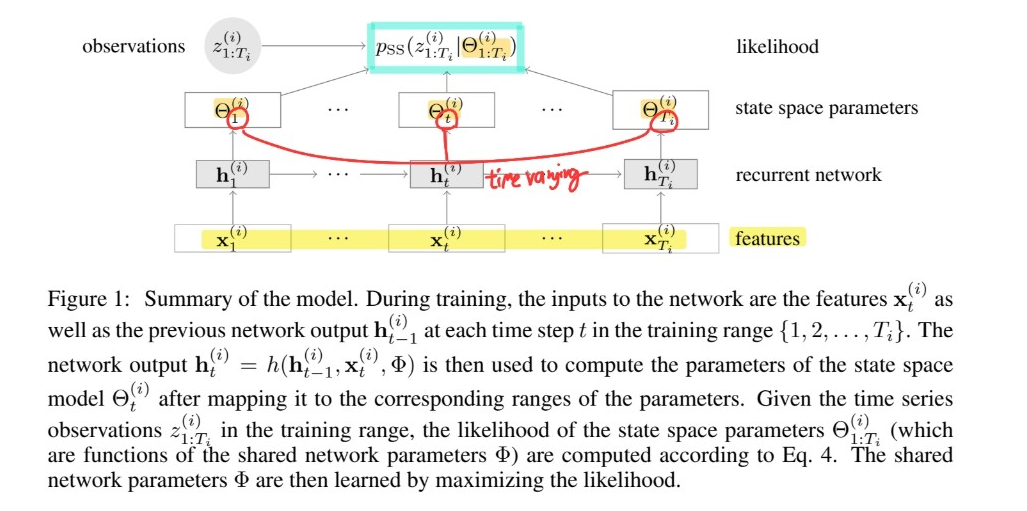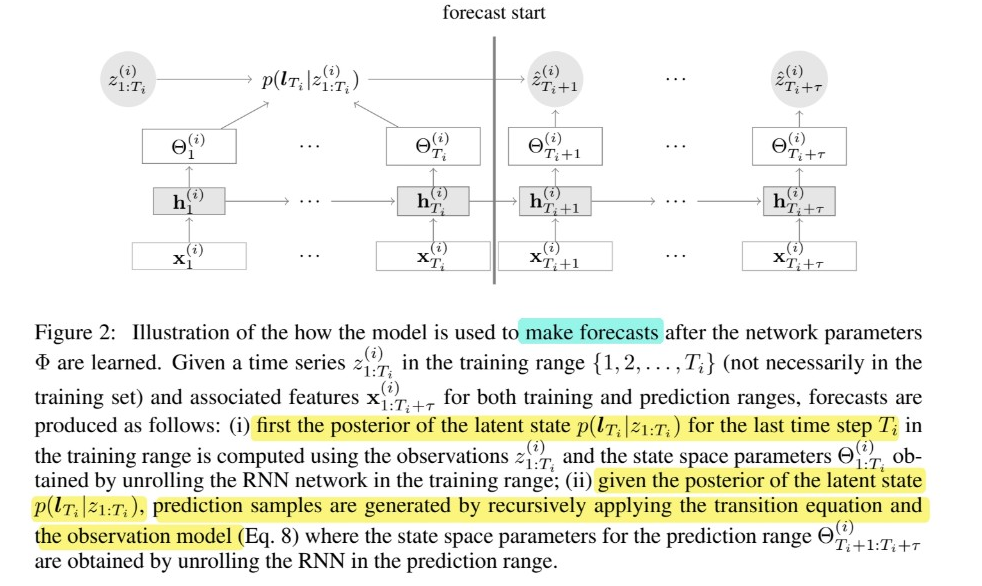Deep State Space Models for TS Forecasting (2018,266)
Contents
- Abstract
- Introduction
- Related Work
- Background
- DSSM (Deep State Space Models)
Abstract
characteristic of DSSM
-
probabilistic TSF model
- SSM + Deep Learning (RNN)
- pros)
- SSM : data efficiency & interpretability
- RNN : learn complex patterns
1. Introduction
(1) State Space models
-
framework for modeling/learning time series patterns ( ex. trend, seasonality )
-
ex) ARIMA, exponential smoothing
-
well suited, when “structure of TS is weel understood”
-
pros & cons
- pros : (1) interpretability + (2) data efficiency
- cons : requires TS with LONG history
-
traditional SSMs cannot infer shared patterns for similar TSs
( fitted separately )
(2) DNN
- pass
(3) DSSM
-
bridge the gap between those two ( SSM + RNN )
-
parameters of RNN are learned “jointly”,
using “TS” & “covariates”
-
interpretable!
2. Related Work
combining SSM & RNNs
- DMM (Deep Markov Model)
- keeps Gaussian transition dynamics with mean/cov matrix parameterized by MLP
- Stochastic RNNs
- Variational RNNs
- Latent LSTM Allocation
- State-Space LSTM
Most relevant to this work is … “KVAE” (Kalman VAE)
- keep the linear Gaussian transition structure intact
3. Background
(1) Basics
Notation
- \(N\) univariate TS : \(\left\{z_{1: T_{i}}^{(i)}\right\}_{i=1}^{N}\)
- \(z_{1: T_{i}}^{(i)}=\left(z_{1}^{(i)}, z_{2}^{(i)}, \ldots, z_{T_{i}}^{(i)}\right)\) .
- \(z_{t}^{(i)} \in \mathbb{R}\) : \(i\)-th time series at time \(t\)
- time-varying covariate : \(\left\{\mathbf{x}_{1: T_{i}+\tau}^{(i)}\right\}_{i=1}^{N}\)
- \(\mathbf{x}_{t}^{(i)} \in \mathbb{R}^{D}\).
Goal : produce a set of PROBABILISTIC forecasts
-
\(p\left(z_{T_{i}+1: T_{i}+\tau}^{(i)} \mid z_{1: T_{i}}^{(i)}, \mathbf{x}_{1: T_{i}+\tau}^{(i)} ; \Phi\right)\).
-
\(\Phi\) : set of learnable parameters
( shared between & learned jointly from ALL \(N\) time series )
-
forecast start time : \(T_{i}+1\)
-
forecast horizon : \(\tau \in \mathbb{N}_{>0}\)
-
range
- training range : \(\left\{1,2, \ldots, T_{i}\right\}\)
- prediction range : \(\left\{T_{i}+1, T_{i}+2, \ldots, T_{i}+\tau\right\}\)
-
(2) State Space Models (SSMs)
- model the “temporal structure”, via “latent state \(l_{t} \in \mathbb{R}^{L}\)“
- general SSM
- 1) state-transition equation
- \(p\left(\boldsymbol{l}_{t} \mid \boldsymbol{l}_{t-1}\right)\).
- 2) observation model
- \(p\left(z_{t} \mid \boldsymbol{l}_{t}\right)\).
- 1) state-transition equation
Linear SSMs
-
\(\boldsymbol{l}_{t}=\boldsymbol{F}_{t} \boldsymbol{l}_{t-1}+\boldsymbol{g}_{t} \varepsilon_{t}, \quad \varepsilon_{t} \sim \mathcal{N}(0,1)\).
- \(\boldsymbol{l}_{t-1}\) : information about level/trend/seasonality
- \(\boldsymbol{F}_{t}\) : deterministic transition matrix
- \(\boldsymbol{g}_{t} \varepsilon_{t}\) : random innovation
-
Univariate Gaussian observation model
-
\(z_{t}=y_{t}+\sigma_{t} \epsilon_{t}, \quad y_{t}=\boldsymbol{a}_{t}^{\top} \boldsymbol{l}_{t-1}+b_{t}, \quad \epsilon_{t} \sim \mathcal{N}(0,1)\).
-
initial state : isotropic Gaussian distribution
- \(l_{0} \sim N\left(\boldsymbol{\mu}_{0}, \operatorname{diag}\left(\boldsymbol{\sigma}_{0}^{2}\right)\right)\).
-
(3) Parameter Learning
parameters of SSMs
- \(\Theta_{t}=\left(\boldsymbol{\mu}_{0}, \boldsymbol{\Sigma}_{0}, \boldsymbol{F}_{t}, \boldsymbol{g}_{t}, \boldsymbol{a}_{t}, b_{t}, \sigma_{t}\right), \forall t>0\).
Classical settings
-
1) dynamics are assumed to be time-invariant
( that is, \(\Theta_{t}=\Theta, \forall t>0\) )
-
2) if there is more than one TS, a separate set of parameters \(\Theta^{(i)}\) is learend,
for each time series
Maximizing marginal likelihood : \(\Theta_{1: T}^{*}=\operatorname{argmax}_{\Theta_{1: T}} p_{S S}\left(z_{1: T} \mid \Theta_{1: T}\right)\)
- \(p_{S S}\left(z_{1: T} \mid \Theta_{1: T}\right):=p\left(z_{1} \mid \Theta_{1}\right) \prod_{t=2}^{T} p\left(z_{t} \mid z_{1: t-1}, \Theta_{1: t}\right)=\int p\left(\boldsymbol{l}_{0}\right)\left[\prod_{t=1}^{T} p\left(z_{t} \mid \boldsymbol{l}_{t}\right) p\left(\boldsymbol{l}_{t} \mid \boldsymbol{l}_{t-1}\right)\right] \mathrm{d} \boldsymbol{l}_{0: T}\).
4 . DSSM (Deep State Space Models)

[ Step 1 ]
learns “TIME VARYING” & “GLOBAL” \(\Theta^{(i)}\)< from…
- 1) covariate vectors \(\mathbf{x}_{1:T_i}^{(i)}\).
- 2) target time series \(z_{1: T_{i}}^{(i)}\)
- shared parameters \(\Phi\)
- \(\Psi\) : RNN
\(\rightarrow\) \(\mathbf{h}_{t}^{(i)}=h\left(\mathbf{h}_{t-1}^{(i)}, \mathbf{x}_{t}^{(i)}, \Phi\right)\)
[ Step 2 ]
model : \(p\left(z_{1: T_{i}}^{(i)} \mid \mathbf{x}_{1: T_{i}}^{(i)}, \Phi\right)=p_{S S}\left(z_{1: T_{i}}^{(i)} \mid \Theta_{1: T_{i}}^{(i)}\right), \quad i=1, \ldots, N\)
(1) Training
maximizing the probability of observing \(\left\{z_{1: T_{i}}^{(i)}\right\}_{i=1}^{N}\) ( training range )
-
\(\Phi^{\star}=\operatorname{argmax}_{\Phi} \mathcal{L}(\Phi)\).
where \(\mathcal{L}(\Phi)=\sum_{i=1}^{N} \log p\left(z_{1: T_{i}}^{(i)} \mid \mathbf{x}_{1: T_{i}}^{(i)}, \Phi\right)=\sum_{i=1}^{N} \log p_{S S}\left(z_{1: T_{i}}^{(i)} \mid \Theta_{1: T_{i}}^{(i)}\right)\).
(2) Prediction

represent forecast distribution, in terms of \(K\) Monte Carlo samples
- \(\hat{z}_{k, T_{i}+1: T_{i}+\tau}^{(i)} \sim p\left(z_{T_{i}+1: T_{i}+\tau}^{(i)} \mid z_{1: T_{i}}^{(i)}, \mathbf{x}_{1: T_{i}+\tau}^{(i)}, \Theta_{1: T_{i}+\tau}^{(i)}\right), \quad k=1, \ldots, K\).
Step 1) compute the posterior \(p\left(\boldsymbol{l}_{T_{i}}^{(i)} \mid z_{1: T_{i}}^{(i)}\right)\) for each time series \(z_{1: T_{i}}^{(i)}\)
-
by unrolling RNN in the training range to obtain \(\Theta_{1: T_{i}}^{(i)}\)
-
then use Kalman filtering algorithm
Step 2) unroll the RNN for the prediction range
- obtain \(\Theta_{T_{i}+1: T_{i}+\tau}^{(i)}\)
Step 3) generate prediction samples
- by recursively applying above equations \(K\) times
